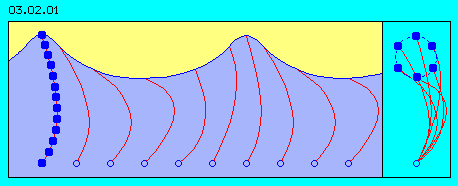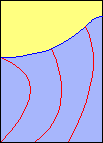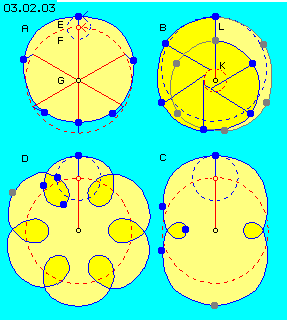Here are discussed sea waves as an appearance of the material world. As mentioned above, these ´material´ movements are not quite similar to possibilities of movements of the aether (because the aether has no parts, opposite e.g. to water). Nevertheless, some essential elements resp. problems of aether movements can well be demonstrated by the example of sea waves.
At picture 03.02.01 schematically is shown a section of ´sea with waves´. The first impression probably is, that wave is not drawn exactly. For us, ´nice´ waves are like sinus-waves. At an earlier chapter for example is shown a wave sinus-shaped (produced by throwing a stone into the water). These waves result a lifting and falling at a symmetric process.
The waves of the sea however are produced and driven by wind (here running from right side to left), and the waves come up by turning water movements. Indeed, these waves show ´valleys´ much longer than ´mountains´, like every water-sportsman knows - and doesn´t like ´short-waved´ seas.
 Deep Waves
Deep Waves
The wave is not only a matter at the surface but waves reach far down in the water. However anywhere deep downside, the water keeps calm, here marked by stationary points downside of the picture.
At this picture left side is marked a line of water parts, from the bottom of resting water up to a waves tip. Further right side are drawn only these ´connecting lines´ between each corresponding water parts. These red lines e.g. could also represent long stalks of seaweed.
If now a wave-mountain becomes a wave-valley (like drawn further right side), the water masses of the mountain has to sink down, i.e. the water previously positioned there has to escape. This motion is marked by diverse connecting lines, all show same length however are bended to right side more or less. The water parts downside are moving similar to the water parts at the surface, in total of same size.
Circled Movement
 At this picture right side, diverse connecting lines from the resting water (starting at one point downside) with their different curves further up are drawn. Resulting is the well known fact, waves in reality exist of turning movements. Waves at a water surface indeed produce the impression of water masses running ahead, however waters in principle stay stationary and are only moving at circled tracks.
At this picture right side, diverse connecting lines from the resting water (starting at one point downside) with their different curves further up are drawn. Resulting is the well known fact, waves in reality exist of turning movements. Waves at a water surface indeed produce the impression of water masses running ahead, however waters in principle stay stationary and are only moving at circled tracks.
This animation shows an even smaller section with that wave ´rolling´ from right to left side. The obvious appearance are water is moving from right to left side, however in reality the water downside is resting and further upward the connecting line of neighbouring water parts is swinging at circled tracks.
Very deep Effect
Water parts can shift alongside each other. Nevertheless the water masses between the connecting lines should be constant, i.e. should show same cross-sectional surface all time. This picture of submarine movies with swinging seaweed is well known, and the distances between these ´trees´ should be constant all times.
At this picture however, it´s obviously not the fact. So the points of ´resting´ water should be much deeper. The appearance of a wave at the surface thus practically is only a symptom of much wider water movements in much deeper regions.
This insight is rather important for movements of the aether, because within the aether no parts can shift alongside inner border surfaces. Within the aether thus each wide movement (analogue to the wave at a water surface) demands rather large area of balancing movements (by really ´astronomic´ relations, e.g. by millions larger distances).
Different Speeds
The water at the surface ´storms´ ahead rather fast, at least the water-mountains, while the water downside swing back relative slow. This process is not to achieve by simple circled movement (like at picture upside), because this turning movement would simply turn with constant speed at a constant radius. Different speeds at different radius demand an overlay of circled movements. Some samples are shown at picture 03.02.03.
At A are marked diverse positions of a water particle during the movement process (blue points). This part of water is turning at a rather short radius (E). It´s turning point (F) by itself is moving at a circled track with rather long radius around second turning point (G).
 Resulting of these both overlaying turning movements is a spiral track (blue and grey) of that water particle. The speed of each section of the track is marked by different distances between the points. Upside are overlaid both movements showing momentary to left side, i.e. there the water moves fast to left side. Downside however, the turning at short radius shows into opposite direction of the turning at long radius, so the water down there moves slowly back to right side.
Resulting of these both overlaying turning movements is a spiral track (blue and grey) of that water particle. The speed of each section of the track is marked by different distances between the points. Upside are overlaid both movements showing momentary to left side, i.e. there the water moves fast to left side. Downside however, the turning at short radius shows into opposite direction of the turning at long radius, so the water down there moves slowly back to right side.
So movements of sea waves are not only simple circled movements, but real movement pattern resulting by overlays of at least two circled movements. This movement-system shown at A, now is overlapped by analogue movement´s pattern at both sides (thus not only next to left and right side, but real overlaps continuously), where each neighbouring movement is phase-shifted (rather important aspect within the aether, described at later chapters).
So each simple sea wave is a system of rather complex overlaying turning movements. These movements are possible within two dimensions (like here at surface of pictures), because the water parts can shift alongside neighbouring parts. Analogue to these processes are movements of the aether, however there are no separated parts, so neighbours can not shift alongside each other. That´s why movements of the aether within the aether all times must occur into all three dimensions same time (as discussed next chapter).
Different Tracks
At following chapters diverse overlays of turning movements are involved. Therefore at this picture 03.02.03 are drawn some further variations.
At B as an example, the radius are arranged vice versa: around the central turning point (K) is drawn a turning at short radius. At each position of that circled track a second turning works at much longer radius (L). Resulting of this combination is a spiral track becoming steady more narrow (positions at blue points) and at the following phase becoming steady wider (positions at grey points).
At C opposite, the constellation is analogue to A, however the radius of the outer turning is some larger and the relation of angles speeds is different. Instead of an oval track (at A), now results two wide and two narrow bows, where the absolute speeds are quite different.
At D, the speed of the outer turning is increased once more, so many loops come up, however the differences of speeds and distances are less.
These few examples may demonstrate, overlays of two circle-round turning movements with each constant turning speed, depending at relations of speeds and radius result most different tracks with most different absolute speeds (like discussed in details at some following chapters)
. These considerations concerning sea waves can not be transferred one-by-one to the movement processes of the aether (because the water exists by particles, however the aether is part-less). Nevertheless, the possibilities like problems shown here are similar within the aether. However, within the aether all movements must show into all three dimension same time - like detailed at following chapter by some geometric aspects.
| 03.03. Volumes and Shapes | Aether-Physics and -Philosophy |